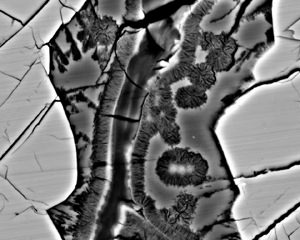[/caption]
Scientists say a close-up look inside rare meteorite fragments from Mars shows evidence that impacts created flowing water near the surface of the Red Planet. At look at five different meteorite samples, including what is thought the be one of the very first Martian meteorite ever found on Earth, shows veins resulting from the impact and serpentine mineralization, which is associated with the production of methane.
PhD student Hitesh Changela and Dr. John Bridges from the University of Leicester used electron microscopes to study the structure and composition of five nakhlite meteorites, including one that was found in 1911 in El-Nakhla in Egypt (the meteorites were named after the location in which they were found). The meteorites had been housed in Natural History Museum, London, and the scientists sliced minute slivers of rock from the samples, about 0.1 microns thick.
By comparing the five meteorites, they showed the presence of veins created during an impact on Mars. Changela and Bridges suggest that this impact was associated with a 1-10 km diameter impact crater, and buried ice melted during this impact, creating flowing water which then deposited clay, serpentine minerals, carbonate and a gel deposit in the veins.
The scientists say their findings tie in with the recent water-related geological discoveries of clay and carbonate on the surface of Mars made by NASA and ESA orbiting spacecraft and the Mars Exploration rovers.
[caption id="attachment_83020" align="aligncenter" width="341" caption="Nanometre scale atomic lattice spacings (measured by high resolution TEM) in serpentine. Credit: University of Leicester"]
[/caption]
"We are now starting to build a realistic model for how water deposited minerals formed on Mars," said Bridges, "showing that impact heating was an important process. The constraints we are establishing about temperature, pH and duration of the hydrothermal action help us to better understand the evolution of the Mars surface. This directly ties in with the current activities of landing site selection for Mars rovers and Mars Sample Return. With models like this we will better understand the areas where we think that water was once present on Mars."
Since serpentine mineralization is associated with the production of methane, the scientists say further research on the meteorites could help show how the methane was produced. A mission heading to Mars in 2016, the Trace Gas Orbiter, will help search for and understand the origin of any methane -- a potential biomarker -- in Mars' atmosphere.
Findings from the research have been published in Meteoritics and Planetary Science (Dec. 2010 issue, vol 45).
Souce:
University of Leicester
 Universe Today
Universe Today
